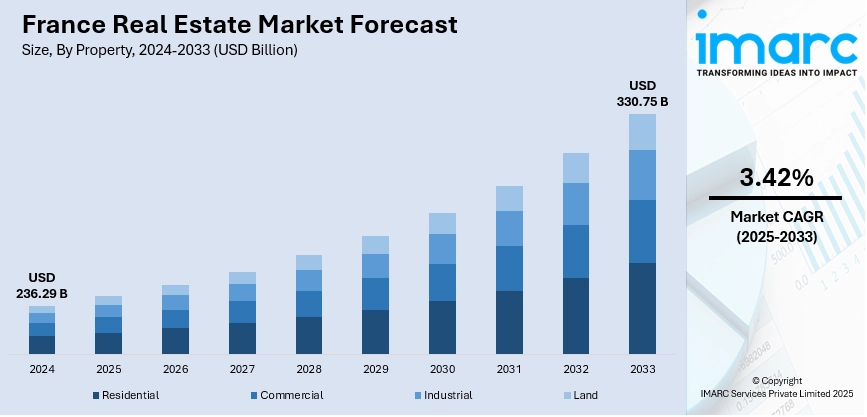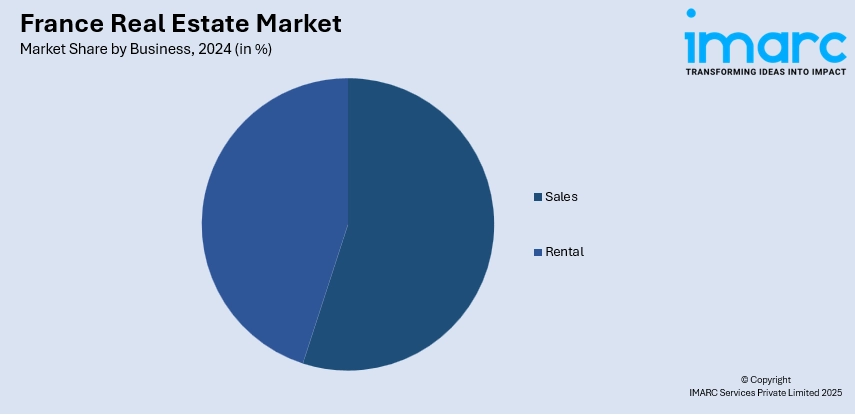
France Real Estate Market Size, Share, Trends and Forecast by Property, Business, Mode, and Region, 2025-2033
France Real Estate Market Overview:
The France real estate market size reached USD 236.29 Billion in 2024. The market is projected to reach USD 330.75 Billion by 2033, exhibiting a growth rate (CAGR) of 3.42% during 2025-2033. The market is experiencing a phase of cautious optimism, shaped by evolving buyer expectations and policy-driven incentives. The shift toward energy-efficient living, supported by government renovation schemes, is influencing both demand and property values. Urban markets are adjusting to remote work trends, leading to growing interest in secondary cities and rural areas. Mortgage conditions have gradually improved, encouraging renewed activity among homebuyers. Meanwhile, sustainability, affordability, and lifestyle quality remain central themes driving France real estate market share.
|
Report Attribute
|
Key Statistics
|
|---|---|
|
Base Year
|
2024
|
|
Forecast Years
|
2025-2033
|
|
Historical Years
|
2019-2024
|
| Market Size in 2024 | USD 236.29 Billion |
| Market Forecast in 2033 | USD 330.75 Billion |
| Market Growth Rate 2025-2033 | 3.42% |
France Real Estate Market Trends:
Urban Regeneration Through Mixed-Use Development
France is actively reshaping its urban centers through government-led renewal programs that prioritize mixed-use developments. Under frameworks such as the Plan Local d’Urbanisme intercommunal (PLUi) and the Opération de Revitalisation de Territoire (ORT), municipal and intercommunal authorities coordinate the redevelopment of outdated districts into lively, multifunctional neighborhoods. These initiatives are supported by instruments like the Projet Partenarial d’Aménagement (PPA) and national urban renewal policies outlined by the Ministère de la Transition écologique. In February 2025, authorities inaugurated two new Métro stations on the Grand Paris Express extension, reinforcing urban renewal in northeastern Paris suburbs through improved transit connectivity. This development is expected to stimulate surrounding mixed-use projects, enabling better integration of residential, commercial, and public spaces while enhancing accessibility for commuter. Public planning tools facilitate the integration of housing, public facilities, green spaces, and cultural venues within a coherent urban structure. Local governments manage land use through density guidelines and zoning rules, while retrofitting old buildings with modern energy standards. These efforts are often linked with improved public-transport connectivity and pedestrian-friendly street layouts, supporting transit-oriented living. By aligning heritage preservation with contemporary housing development, these official strategies are key contributors to France real estate market growth, enhancing both neighborhood appeal and long-term investment viability.

To get more information on this market, Request Sample
Green Innovation Reshaping Real Estate Development
Environmental sustainability is increasingly shaping the future of real estate in France, as the industry adapts to evolving climate priorities and regulatory demands. Green construction practices are becoming standard, with new developments integrating high-efficiency insulation, solar energy systems, and smart technologies to improve energy performance. This shift is not only helping France meet its carbon reduction targets but also aligning with growing consumer preferences for eco-conscious, cost-efficient homes. The growing prevalence of green building certifications and the use of sustainable construction materials reflect the sector’s deepening commitment to environmentally responsible design. In parallel, urban policies are supporting the expansion of low-carbon transportation, walkable neighborhoods, and green infrastructure. These efforts are strengthening long-term investor confidence by embedding sustainability into the core of market growth. As a result, eco-friendly development is now a defining pillar of France real estate trends, reinforcing the country’s leadership in Europe’s transition toward sustainable urban living.
Rise of Secondary City Residential Markets
Secondary cities in France such as Lyon, Nantes, Bordeaux, and Montpellier are emerging as desirable residential hubs, driven by national efforts to promote balanced territorial development. Supported by government-led decentralization strategies and sustainable urban planning, these cities offer robust public transport networks, modern infrastructure, and a high quality of life. Intercommunal authorities, operating under planning frameworks like the Schémas de cohérence territoriale (SCOT), are harmonizing land use and development across municipalities to foster integrated growth. Policies that promote infill construction and mixed-use districts are aligning housing expansion with green spaces and mobility systems. In parallel, the nationwide enforcement of energy performance diagnostics (DPE), including in older buildings, is steadily enhancing the standard of regional housing. These coordinated planning and environmental measures are decentralizing housing demand and cultivating well-connected, livable communities. This geographic diversification underpins France’s real estate market growth, creating stability and broadening residential choices beyond traditional metropolitan centers.
France Real Estate Market Segmentation:
IMARC Group provides an analysis of the key trends in each segment of the market, along with forecasts at the country and regional levels for 2025-2033. Our report has categorized the market based on property, business, and mode.
Property Insights:
- Residential
- Commercial
- Industrial
- Land
The report has provided a detailed breakup and analysis of the market based on the property. This includes residential, commercial, industrial, and land.
Business Insights:

- Sales
- Rental
A detailed breakup and analysis of the market based on the business have also been provided in the report. This includes sales and rental.
Mode Insights:
- Online
- Offline
A detailed breakup and analysis of the market based on the mode have also been provided in the report. This includes online and offline.
Regional Insights:
- Paris Region
- Auvergne-Rhône-Alpes
- Nouvelle-Aquitaine
- Hauts-de-France
- Occitanie
- Provence Alpes Côte d’Azur
- Grand Est
- Others
The report has also provided a comprehensive analysis of all the major regional markets, which include Paris Region, Auvergne-Rhône-Alpes, Nouvelle-Aquitaine, Hauts-de-France, Occitanie, Provence Alpes Côte d’Azur, Grand Est, and others
Competitive Landscape:
The market research report has also provided a comprehensive analysis of the competitive landscape. Competitive analysis such as market structure, key player positioning, top winning strategies, competitive dashboard, and company evaluation quadrant has been covered in the report. Also, detailed profiles of all major companies have been provided.
France Real Estate Market News:
- January 2025: Kering, the luxury group behind brands like Gucci and Saint Laurent, has agreed to sell a majority stake in three prime Parisian retail properties to Ardian, a French private equity firm. The portfolio includes prestigious locations on Place Vendôme and Avenue Montaigne. Kering retains a minority stake and brand tenancy while freeing up capital, aligning with its strategy to maintain brand visibility yet ease financial burdens. The deal, structured as a joint venture, reflects a growing trend among luxury conglomerates to optimize real estate investments.
- February 2025: AG Real Estate retailing firm Henderson Park, working with Paris-based asset manager Atream, has acquired five Novotel Suites hotels spread across key French cities. These midscale properties will remain under Accor’s management while Henderson Park leads upgrades targeting guest rooms, public areas, and technical systems. The aim is to modernize operations, enhance energy efficiency, and streamline asset control by unifying property ownership and operations. This marks a strategic move by both companies to improve hospitality assets in France’s competitive tourism sector.
France Real Estate Market Report Coverage:
| Report Features | Details |
|---|---|
| Base Year of the Analysis | 2024 |
| Historical Period | 2019-2024 |
| Forecast Period | 2025-2033 |
| Units | Billion USD |
| Scope of the Report |
Exploration of Historical Trends and Market Outlook, Industry Catalysts and Challenges, Segment-Wise Historical and Future Market Assessment:
|
| Properties Covered | Residential, Commercial, Industrial, Land |
| Businesses Covered | Sales, Rental |
| Modes Covered | Online, Offline |
| Regions Covered | Paris Region, Auvergne-Rhône-Alpes, Nouvelle-Aquitaine, Hauts-de-France, Occitanie, Provence Alpes Côte d’Azur, Grand Est, Others |
| Customization Scope | 10% Free Customization |
| Post-Sale Analyst Support | 10-12 Weeks |
| Delivery Format | PDF and Excel through Email (We can also provide the editable version of the report in PPT/Word format on special request) |
Key Benefits for Stakeholders:
- IMARC’s industry report offers a comprehensive quantitative analysis of various market segments, historical and current market trends, market forecasts, and dynamics of the France real estate market from 2019-2033.
- The research report provides the latest information on the market drivers, challenges, and opportunities in the France real estate market.
- Porter's five forces analysis assist stakeholders in assessing the impact of new entrants, competitive rivalry, supplier power, buyer power, and the threat of substitution. It helps stakeholders to analyze the level of competition within the France real estate industry and its attractiveness.
- Competitive landscape allows stakeholders to understand their competitive environment and provides an insight into the current positions of key players in the market.
Key Questions Answered in This Report
The market in France was valued at USD 236.29 Billion in 2024.
The France real estate market is projected to exhibit a CAGR of 3.42% during 2025-2033, reaching a value of USD 330.75 Billion by 2033.
The market is driven by government-backed renovation schemes promoting energy-efficient housing, improved mortgage conditions, and the rise of secondary city markets due to remote work trends. Growing interest in sustainable construction, urban regeneration initiatives, and balanced territorial development further strengthen market demand and investment.
Need more help?
- Speak to our experienced analysts for insights on the current market scenarios.
- Include additional segments and countries to customize the report as per your requirement.
- Gain an unparalleled competitive advantage in your domain by understanding how to utilize the report and positively impacting your operations and revenue.
- For further assistance, please connect with our analysts.
 Request Customization
Request Customization
 Speak to an Analyst
Speak to an Analyst
 Request Brochure
Request Brochure
 Inquire Before Buying
Inquire Before Buying




.webp)




.webp)












